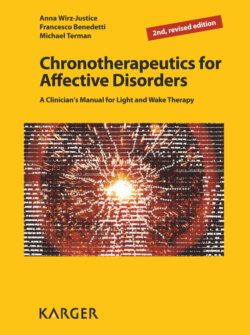Читать книгу Chronotherapeutics for Affective Disorders - M. Terman - Страница 17
На сайте Литреса книга снята с продажи.
1.7 How It All Began: Light Therapy for Seasonal Affective Disorder
Оглавление2005 was a signal year for the field, with consensus achieved by an American Psychiatric Association work group that light can serve as a firstline treatment intervention for both seasonal and non-seasonal depression [28]. In other words, expert clinicians have judged the evidence for light therapy as a viable alternative or adjunct to antidepressant drugs [29, 30].
But how did it all begin? The diagnosis of SAD and the analogy with hamster hibernation cycles led to the development of light therapy in the early 1980s [31]. (We must note that the pharmaceutical industry has recently tried to rechristen SAD as seasonal major depressive disorder (sMDD), a misnomer which arbitrarily excises seasonal bipolar depression from the category.) The idea was simple: lengthening the daily photoperiod (in effect, mimicking summer day length) would lead to remission of winter depressive symptoms. Since that time, many centres around the world have conducted studies using bright light in various protocols and applications [32, 33]. These studies have refined the clinical issues involved in use of bright light therapy, showing, for example, that it is not necessary to mimic the length of a spring or summer day for a remission of depressive symptoms, but merely to deliver the light pulse (which can be as short as 30 min) to signal a springtime sunrise to the brain. More than thirty years of clinical and neurobiological research support the diagnosis of SAD (Bipolar or Major Depressive Disorder, Recurrent, with Seasonal Pattern, by DSM-IV criteria) (table 3).
Fig. 10. Schematic representation of different manipulations of sleep timing and duration on the response of depressed patients (based on 30 years of clinical trials). A sleep-sensitive circadian phase in the second half of the night appears to be crucial in that being awake at this time can trigger improvement.
The response to light in SAD is often remarkable and consistent, as exemplified by a patient whose depression ratings were followed weekly for 4 years (fig. 11).
